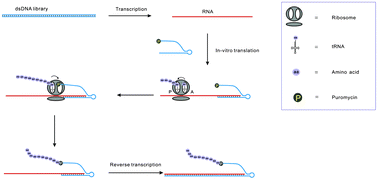DNA display for drug discovery†
Abstract
A novel DNA display strategy, based on a new

* Corresponding authors
a
Natural Products Research Center, Chengdu Institute of Biology, Chinese Academy of Sciences, Chengdu 610041, P. R. China
E-mail:
tangzhuo@cib.ac.cn
Fax: +86 28 85243250
Tel: +86 28 85243250
b College of Life Sciences, Sichuan University, Chengdu 610064, P. R. China
c University of Chinese Academy of Sciences, Beijing 100049, P. R. China
A novel DNA display strategy, based on a new

 Please wait while we load your content...
Something went wrong. Try again?
Please wait while we load your content...
Something went wrong. Try again?
H. Chen, G. Chen, F. Du, Q. Fu, Y. Zhao and Z. Tang, RSC Adv., 2013, 3, 16251 DOI: 10.1039/C3RA42440E
To request permission to reproduce material from this article, please go to the Copyright Clearance Center request page.
If you are an author contributing to an RSC publication, you do not need to request permission provided correct acknowledgement is given.
If you are the author of this article, you do not need to request permission to reproduce figures and diagrams provided correct acknowledgement is given. If you want to reproduce the whole article in a third-party publication (excluding your thesis/dissertation for which permission is not required) please go to the Copyright Clearance Center request page.
Read more about how to correctly acknowledge RSC content.
 Fetching data from CrossRef.
Fetching data from CrossRef.
This may take some time to load.
Loading related content
